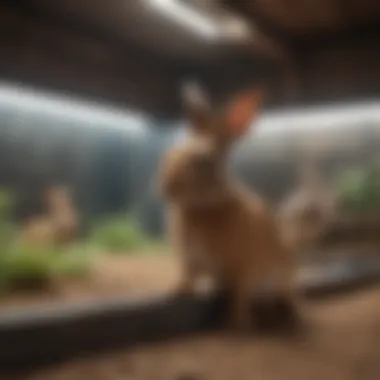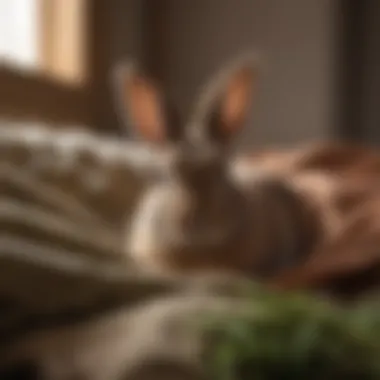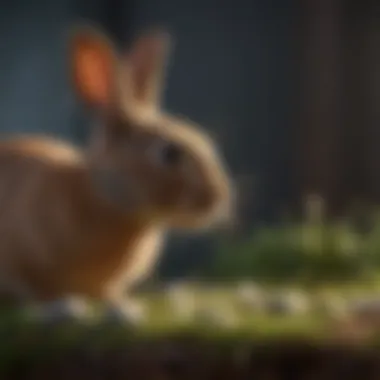Creating the Perfect Habitat for Pet Rabbits


Intro
Creating a suitable habitat for pet rabbits is not just about providing a physical space; it's about understanding who they are as creatures. These small, often overlooked animals bring joy, companionship, and a unique set of needs that, when met, can lead to a happy and long life. This guide endeavors to equip pet owners with the essential knowledge required to create an ideal environment where their bunnies can thrive.
Understanding Your Pet
Pet Behavior Basics
Rabbits may give the impression of being quiet and passive, but they’re actually complex creatures with distinct behaviors. They often exhibit a wide array of emotional responses and have specific signals they use to communicate. For example, a rabbit thumping its hind legs is signaling potential danger or discomfort. Likewise, when they jump and zoom around in what is commonly referred to as a "binky," it’s a revelatory sign of joy and comfort. Understanding these behaviors is instrumental in fostering a positive relationship with your pet.
Common Breed Characteristics
Not all rabbits are created equal. Various breeds exhibit different temperaments and physical traits. For instance, a Holland Lop is typically more docile and easy-going, whereas a Mini Rex might be a tad more energetic. Recognizing these differences can help you tailor your rabbit’s living environment and activities to suit their specific personality and breed characteristics.
Species-Specific Needs
Rabbits require more than just food and water; they need a stimulating environment. They thrive on social interaction, both with humans and other rabbits. Providing adequate space is crucial, as these animals are natural diggers and runners. A cramped area can lead to stress and unhealthy behaviors. Whether they are indoors or outdoors, their living conditions must resemble a mini-ecosystem tailored to their innate instincts and lifestyles.
Pet Care and Maintenance
Feeding Guidelines
Proper nutrition is vital for a rabbit's well-being. High-quality hay should be the cornerstone of their diet, supplemented with fresh vegetables and a limited amount of pellets. Foods like romaine lettuce, basil, and parsley offer essential nutrients and variety. However, some foods, like iceberg lettuce, should be avoided as they may lead to dietary issues.
Grooming Essentials
Regular grooming is essential, especially for long-haired breeds. Brushing helps prevent matting and excessive shedding. Additionally, check their ears and nails regularly to ensure good hygiene. Keeping your rabbit clean can be a part of your bonding time, plus it enhances their overall health.
Hygiene Practices
A clean environment is crucial to prevent diseases. Regularly clean the litter box—ideally daily—and ensure that bedding is dry and free from waste. Spot-clean any soiled areas and replace bedding as needed to keep your rabbit's habitat healthy and fresh.
Training and Development
Basic Commands and Skills
Training your rabbit can be rewarding for both of you. Start with simple commands; you might be surprised at how quick they can learn. For instance, teaching them to come when called can enhance your interaction and make them feel more secure. Using treats can help reinforce positive behaviors.
Behavioral Training Techniques
Positive reinforcement works wonders with rabbits. Rewards like treats or additional run time can encourage good behaviors. It's important to be patient, as every rabbit has its own learning pace.
Addressing Common Behavior Issues
Ignoring behavioral problems will likely lead to increased stress for your pet. Common issues include chewing furniture or excessive digging. Redirection towards appropriate toys or chew items can be beneficial in curbing such behaviors.
Health and Wellness
Routine Vet Check-ups
Planning for routine veterinary check-ups is essential in maintaining your rabbit's health. Regular visits allow for monitoring of their weight, teeth, and overall health, which can preempt potential issues.
Vaccination Needs
Depending on your location, certain vaccinations may be necessary to protect your rabbit from critical diseases. Discuss with your veterinarian about any required vaccines to keep your pet safe.
Recognizing Signs of Illness
Being aware of changes in your rabbit’s behavior, appetite, or litter habits can be vital signs of illness. A sudden shift, like lack of grooming or hiding, might indicate discomfort or health issues requiring immediate attention.
Enrichment and Activities
Indoor vs. Outdoor Activities
Whether you keep your rabbit indoors or outdoors will influence the types of activities they can engage in. Indoor rabbits can enjoy tunnels and ramps, while outdoor rabbits may benefit from safely fenced areas where they can dig and explore.


Interactive Toys and Games
Bunnies love to play! Providing them with toys can stave off boredom and encourage physical activity. Look for chew toys, tunnels, or puzzle feeders designed specifically for rabbits to engage their minds and bodies.
Socialization Opportunities
Rabbits are social creatures and benefit from interaction with other pets or humans. If you choose to house more than one rabbit, ensure they are spayed or neutered to prevent unwanted litters and to promote harmonious living. Regular socialization can help keep them happy and well-adjusted.
Creating a safe and stimulating habitat is a journey that requires commitment. When you invest time and care into your rabbit's living conditions, you foster not only their well-being but also a lasting bond that enriches both your lives.
Understanding Rabbit Housing Needs
Creating the right environment for rabbits isn’t just about four walls and a roof; it’s about ensuring they can flourish. The significance of understanding rabbit housing needs goes beyond mere aesthetics—it's crucial for their physical and psychological well-being. Rabbits are social creatures with natural instincts that must be considered when establishing their home. A proper habitat can prevent behavioral issues and health concerns that stem from inadequate living conditions.
Why Housing Matters
At the core, housing impacts a rabbit's quality of life. Without adequate shelter, they can feel exposed to predators, leave them perpetually anxious. Think of it this way: if you lived in a rickety old shack, not only would you feel unsafe, but you'd probably also grow increasingly agitated. In contrast, a secure and well-designed space allows rabbits to dig, hide, and hop around freely, reminiscent of their natural burrowing habits. A proper habitat encourages natural behaviors which, in turn, leads to healthier, happier pets.
"An appropriate habitat fosters a sense of security and well-being in rabbits."
Assessing Space Requirements
When it comes to space, rabbits are surprisingly expansive in their needs. The amount of space required depends largely on the size and breed of the rabbit.
- Small breeds (like Netherland Dwarfs) might manage in a smaller area compared to larger breeds (like Flemish Giants).
- General Recommendation: Aim for at least 12 square feet of living space for a single rabbit, though more is always better.
- Exercise Area: In addition to living space, consider an area for them to stretch their legs and hop around safely. This could be a designated playpen or safe room where they can explore without restrictions.
It’s vital to make a careful assessment of the space available. A cramped space does not just mean less room to feel comfortable; it can also mean less room for social interaction if you have multiple rabbits.
Indoor vs. Outdoor Housing
Both indoor and outdoor environments come with their own pros and cons. Let's examine some of them:
- Indoor Housing
- Outdoor Housing
- Pros: Closer supervision, protection from predators, regulated climate.
- Cons: Potential for less space if not carefully planned.
- Pros: More space for roaming and exploring, connections to nature.
- Cons: Exposure to weather, predators, and parasites. Also requires more effort to ensure safety and cleanliness.
Ultimately, choice of housing should depend on your lifestyle and what makes the most sense for the rabbit's needs. Indoor spaces can often be improved with multi-level enclosures or rabbit-proofed areas, while outdoor setups must prioritize security and protection from the elements.
Designing the Ideal Habitat
When it comes to ensuring a rabbit’s well-being, the design of their habitat can make a world of difference. It's not just about throwing together some bits and bobs; it involves careful thought about comfort, safety, and the unique quirks that rabbits exhibit. An ideal habitat answers the needs of these sensitive creatures. They thrive where there's space to hop, nibble, and cozy up in their own private nook.
In this segment, we’ll dig into key aspects around creating an ideal living space. This isn't just a casual setup; it’s about crafting an environment that encompasses proper materials, safety measures, and essential comforts.
Selecting Suitable Materials
Choosing appropriate materials is fundamental when it comes to rabbit habitats. Rabbits are known for their chewing habits, and because of this, the materials used should be durable yet safe.
For example, using untreated wood for a structure is critical because treated wood contains chemicals that can be harmful to rabbits. If you decide to use plastic, remember that it should be free from BPA or other toxins. The right materials ensure a habitat that stands the test of time while also providing a safe haven for your furry friend.
Creating a Safe Environment
Ensuring a rabbit's safety is paramount. Identifying hazards can protect them from potential dangers that might lurk in their living space.
Identifying Hazards
When you dive into the task of identifying hazards, think about anything that might be harmful to your rabbit. Sharp edges, toxic plants, and even small items that can be swallowed can pose serious risks. The key characteristic of this aspect is vigilance. By keeping a keen eye on their surroundings, you can prevent accidents before they happen.
It’s a beneficial choice for your rabbit’s safety because it addresses potential threats head-on. This proactive approach not only safeguards your pet but also promotes their overall well-being.
Using Non-Toxic Materials
In addition to identifying hazards, using non-toxic materials is another essential aspect. Choosing safe materials goes hand in hand with ensuring safety. For instance, organic fabrics or biodegradable plastics are alternatives that minimize risk.
This choice is particularly important since rabbits are prone to chewing everything. If they ingest something toxic, the repercussions can be dire. The unique feature of non-toxic materials lies in their peace of mind; having a sense that your rabbit’s environment is safe is worth its weight in gold.


Essential Features for Comfort
Beyond safety, essential comfort features transform a simple cage into a cozy home. Providing hiding spots and temperature control are key elements.
Providing Hides and Shelters
Hiding spots are vital for rabbits since they naturally seek shelter from potential predators. Without a safe place to dart into, they can feel stressed and exposed. Incorporating various hideouts can help them stay calm, particularly during busy household times or loud noises.
The benefit here is that it replicates their natural instincts, allowing them to feel secure. A unique feature of these shelters could be small cardboard boxes or wooden tunnels, which offer more than just a hideaway; they come to be their favorite hangout spots too.
Temperature Control
Temperature control cannot be overemphasized. Rabbits are sensitive to extremes in temperature, so their habitat should be designed to stay cool in the summer and warm as the winter chill sets in. Adding ventilation openings, but not direct drafts, can help maintain a comfortable environment.
This aspect is beneficial since it ensures rabbits can enjoy their home without stress from fluctuating weather conditions. You might also include thermal insulation around the habitat, which would minimize temperature swings without creating a stuffy environment.
Maintaining Cleanliness and Health
Keeping a rabbit's habitat clean is not just a chore; it's a fundamental aspect of responsible pet ownership. Cleanliness directly impacts the health and well-being of your furry friend. A clean environment helps prevent disease, reduces odor, and makes for a more pleasant living space, for both the rabbits and their human caregivers. Ignoring this essential part of pet care can lead to behavioral issues, stress, and a host of health complications. Let’s explore the methods and practices that ensure a rabbit’s living area remains spick and span.
Daily Cleaning Routines
A daily cleaning routine is vital. This practice should include several straightforward steps:
- Tidy Up: Clear away uneaten food and leftover hay. These can attract unwanted pests and lead to spoilage.
- Spot Clean: Using a pet-safe cleaner, wipe down any soiled areas, particularly around the litter box.
- Change Water: Refresh the rabbit's drinking water every day to prevent bacteria growth.
- Check Bedding: If it's in a cage or pen, ensure that bedding remains clean and dry; replace it if it’s damp or dirty.
Incorporating these practices into your daily routine is simple enough and goes a long way in maintaining a healthy space.
Deep Cleaning Procedures
Every month or so, a more thorough approach is necessary. This deep cleaning process might look like:
- Remove All Items: Take out food bowls, litter boxes, and bedding materials.
- Wash: Clean all removable items using warm, soapy water or a vinegar solution for natural disinfection. Rinse thoroughly to avoid any residue.
- Scrub Habitats: Use a non-toxic cleaner to scrub the entire space—walls, floors, and any surfaces rabbits come into contact with.
- Dry Completely: Make sure all parts are dry before putting bedding and other possessions back. Wet surfaces can harbor bacteria or mold, which can be harmful
Keeping up with deep cleans helps maintain hygiene and makes it easier to spot any potential issues before they escalate.
Monitoring for Health Issues
Monitoring your rabbits for health issues should be a part of your daily interactions with them. This vigilance can be crucial in catching problems early, sometimes before they become serious.
Behavioral Changes
One major indicator of a rabbit's health is their behavior. Whenever you notice your pet acting unusually, it might be a sign that something is off. For instance, if your lively rabbit suddenly becomes lethargic, or if they stop eating or drinking, it signals a potential issue.
Behavioral changes also extend to social interactions; a rabbit that begins to hide or is less curious could be feeling unwell or stressed. Being attuned to these shifts enables you to take action swiftly, which can make all the difference in a timely intervention.
Signs of Illness
Another critical aspect of monitoring health is recognizing signs of illness. This can include anything from a loss of appetite, changes in fecal output, or unusual grooming habits. If a rabbit's fur appears matted or they're developing red eyes, these can be clues pointing to underlying issues.
This vigilance can foster a deeper understanding of your pet's needs and ensures any necessary veterinary attention is received promptly. Knowing what to look for is vital if you aim to provide the best care possible.
Key Takeaway: Regular cleanliness routines and vigilance with behavioral changes and signs of illness create a strong foundation for your pet’s health, promoting longevity and happiness.
Enhancing Rabbit's Quality of Life
In the realm of caring for pet rabbits, enhancing their quality of life is not just a luxury but rather an essential aspect of their overall well-being. A happy rabbit is a healthy rabbit, and adding layers of comfort, enrichment, and socialization can significantly improve their day-to-day experiences. When rabbits thrive, they not only display better health but can also exhibit more playful and affectionate behaviors, making the bond with their human companions even stronger.
Enrichment Activities
Just like humans, rabbits appreciate a good mix of mental and physical stimulation. Enrichment activities are vital for rabbits. They can easily become bored if not provided with ways to engage their minds and bodies.
Some enriching activities include:
- Interactive toys: These can range from simple cardboard boxes to complex maze-like toys that stimulate their natural instincts.
- Foraging opportunities: Hiding some of their treats in different places around their habitat encourages them to explore and work for food, which is a natural behavior for them.
- Obstacle courses: Setting up an area where they can hop over, crawl under, and navigate around objects mimics their instinct to explore and be active.
Engagement through play helps prevent behavioral issues and ensures that they remain happy, validating the importance of variety in their daily lives.
Socializing and Bonding


Building a bond with your rabbit is rewarding but requires understanding their nature. Socializing rabbits not only enhances their quality of life but also provides them with a sense of security and companionship.
Understanding Rabbit Behavior
Understanding rabbit behavior is crucial. Rabbits are prey animals, which makes them naturally wary of their surroundings. Familiarity with their unique traits helps owners provide a nurturing environment.
One key characteristic of rabbit behavior is their social nature. Rabbits thrive in groups, which makes companionship vital. When they feel safe, they are more likely to engage in playful behaviors and explore their habitat.
This understanding serves as a foundation for improving their habitat and addressing their needs. Having a keen insight into why rabbits behave the way they do transforms the way owners interact with them, emphasizing patience and gentle handling.
Introducing New Companions
Introducing new companions to your rabbit can be beneficial as well but must be done with careful consideration. Sometimes, a second rabbit can help alleviate boredom and loneliness. However, the introduction should be gradual.
The preference for new companions may vary; while some rabbits welcome others, others might take time. The unique feature of this bonding experience is establishing a hierarchy within their social structure. Rabbits are territorial and will need time to adjust, so owners should monitor their interactions closely.
Providing careful introductions and allowing them to establish rapport in their own time can strengthen their bond significantly. The benefits include increased mental stimulation and a more dynamic and engaging living environment for both rabbits.
Providing Proper Nutrition Access
Nutritional access is another cornerstone of enhancing a rabbit's quality of life. Rabbits have specific dietary needs that must be met for them to thrive. A proper diet includes fresh hay, fresh vegetables, and a limited amount of pellets. Having easy access to these foods encourages healthy eating habits and keeps them energetic.
By prioritizing these aspects, rabbit owners can indeed create a joyful and harmonious living environment that nurtures the rabbits’ nature, allowing them to flourish both physically and mentally.
Common Misconceptions About Rabbit Housing
Understanding the common misconceptions about rabbit housing is crucial for any rabbit owner. These myths can lead to decisions that may negatively affect the well-being of these sensitive creatures. By dispelling the myths surrounding rabbit housing, pet owners can create a much more suitable environment that meets the rabbits' needs for space, comfort, and activity. If you know what’s true, you can make more informed choices for a happy, healthy bunny.
Rabbits Need More Space
One prevalent belief is that rabbits need an abundance of space to thrive. It’s often assumed that they should roam freely throughout the house, similar to dogs. While it's true that rabbits need space to hop around and exercise, the reality is more nuanced. A rabbit's personality plays a significant role in determining their space requirements. Some rabbits are perfectly comfortable in a confined area, provided it is enriched with tunnels, hideouts, and toys. The emphasis should be on enriching their environment rather than solely focusing on the square footage.
- Considerations for space:
- Rabbits need safe areas for exercise.
- They should have spaces to explore and play.
- Quality is often more important than quantity.
Ultimately, it's not just about having a large space; it’s about how that space is utilized. A smaller area filled with engaging activities can often lead to just as happy and healthy a rabbit as a vast but empty space.
Active Time vs. Sleeping Quarters
Another misunderstanding is regarding the distinction between a rabbit’s active time and their sleeping quarters. People may think that these areas should be entirely separate, but rabbits often benefit from having access to both play and rest areas within the same space. Rabbits are crepuscular, meaning they are most active during the dawn and dusk hours. During the day when they are less active, they often seek out cozy places to nap.
A good housing design takes both aspects into consideration:
- Active Areas: Rabbits need room to run, jump, and play. This space should include:
- Sleeping Quarters: A safe, quiet space is essential for napping. It should include:
- Toys and tunnels for exploration.
- Interactions with their owners or other rabbits, were applicable.
- Hiding spots or covered areas where they feel secure.
- Soft bedding materials for comfort.
"Rabbits will thump their hind legs as a warning; this is a cue to understand that they are feeling insecure or threatened in their environment."
Resources and Tools for Rabbit Owners
A pet owner’s journey begins with recognizing that rabbits are like any other pet – they need thoughtful consideration when it comes to their living conditions. Having access to the right resources not only enhances their habitat but also supports their health and happiness.
Recommended Housing Options
When it comes to rabbit housing, having the right choice can lay the groundwork for a thriving bunny home. Here are some popular options:
- Indoor Cages: Often suitable for smaller breeds, these cages should be spacious enough for your rabbit to stand, hop, and lie comfortably.
- Outdoor Hutches: Ideal for rabbits who enjoy fresh air and sunlight. Ensure these are elevated off the ground, offering protection from the elements.
- Playpens: These provide a secure space for rabbits to move freely, promoting exercise and exploration while keeping them safe from harm.
- Custom-built Enclosures: For owners inclined to craft something unique, building an enclosure allows you to cater specifically to your rabbit's needs and preferences.
Consider your living space, available time for supervision, and whether your rabbits will need an indoor or outdoor setup. A well-chosen housing option fosters a secure feeling, which is key to their well-being.
Essential Care Supplies
Creating a comfortable environment also requires essential supplies. The right tools can significantly enhance the daily life of your rabbit. Here’s what you might want to have on hand:
- Bedding materials: Use aspen shavings or paper-based bedding which are safe and help absorb urine. Avoid cedar and pine shavings due to their phenols that can irritate your rabbit's lungs.
- Litter boxes: Training rabbits to use litter positively impacts cleanliness and health. Choose a litter made from natural materials, like paper or wood pellets.
- Food and water dishes: Opt for heavy ceramic bowls that won’t tip over easily. Keep water fresh and clean daily; consider using a bottle if your bunny prefers that to a bowl.
- Toys and chews: Enriching a rabbit’s environment is crucial. Wooden chew toys, tunnels, and balls made for rabbits encourage play and mental stimulation.
- Grooming supplies: A brush will help keep your rabbit’s coat in good shape, especially long-haired breeds. Regular grooming reduces shedding and helps prevent matting, providing comfort for your pet.
Together, all these elements build a sanctuary that allows your rabbit to feel secure and content. By investing in the right resources and tools, you can turn an ordinary space into a thriving habitat.
It's essential to keep changing and updating your tools as your rabbit's needs evolve. Regularly interact and observe your pet to gauge what they enjoy and require.







